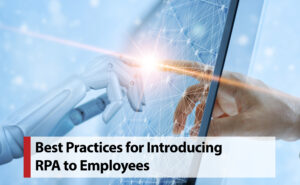Studies have shown that ineffective organizational change management is the leading cause of RPA failure*. Introducing this revolutionary technology to employees through efficient change management can mean the difference between Robotic Process Automation success and failure.

*According to the Global IA Report by the Shared Services and Outsourcing Network (SSON), 44% of businesses reported that a lack of effective change management was the number one reason why their RPA implementation efforts failed.
Implementing Robotic Process Automation (RPA) in your business is so much more than just a technology project to streamline business processes and increase efficiency. It is an initiative that affects everyone in your company, and as such, it is crucial to focus on the “people side” of implementation just as much, if not more, than you would on the software developments. This mindset shift from a focus on technology to a focus on people will allow you to prepare your employees to embrace the implementation process and make the most of the new technology available to them.
Organizational change management is the process of communicating upcoming changes to team members in an effort to ensure that they are well equipped with the knowledge, understanding, and skillsets required to successfully work with the new software.
Follow these change management best practices to introduce RPA to your employees in order to ensure that your RPA implementation is successful.
Prepare an introductory demonstration
There is a common misconception that automation technology, like RPA, will replace human employees, and make their jobs redundant. This is, of course, completely untrue. As revolutionary as RPA software is, there is only so much that these robots can actually do. The reality is that the software will only automate those elements of the job that are repetitive, mundane, time-consuming, and rather quite dull. Educate your people straight from the start, show them exactly what the software can do and how it can, and will, benefit them.
Encourage input
Engage with employees to come up with ideas of where automation can be used in the organization. Not only will this encourage innovation and buy-in, but it will highlight whether your people have a good understanding of where and how RPA software can be used.
Get management buy-in, and communicate every step of the way
Support and buy-in from senior management should flow down through to employees, and a thorough understanding of the software and the implementation process will allow management to educate and keep employees updated so that they know exactly what to expect at every stage of the project.
Train and upskill
Ensure that your RPA implementation partner offers training to upskill employees, and be sure to reward participation.
Celebrate successes, and acknowledge setbacks
Businesses that benefit most from RPA implementation will consider their people’s needs as well as those of the company. Rather than trying to sell employees on theoretical advantages of Robotic Process Automation, communicate how the technology will directly benefit them by making their jobs less routine and freeing them up for higher-value work. Actively involve them in the implementation process and reward their interest and buy-in. This will win them over and help to ensure that your RPA implementation is successful.
Are you ready to implement RPA to transform your business? Make sure to partner with the right experts to ensure that your attempts do not fail. With over 15 years of industry experience, Connections are here to help. FIND OUT MORE.
